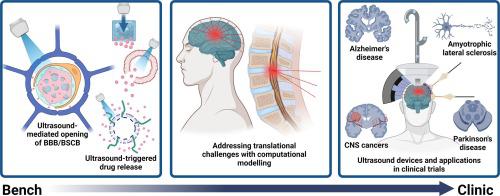当前位置:
X-MOL 学术
›
Adv. Drug Deliver. Rev.
›
论文详情
Our official English website, www.x-mol.net, welcomes your feedback! (Note: you will need to create a separate account there.)
Translating ultrasound-mediated drug delivery technologies for CNS applications
Advanced Drug Delivery Reviews ( IF 16.1 ) Pub Date : 2024-03-06 , DOI: 10.1016/j.addr.2024.115274 Ederlyn Perolina , Svenja Meissner , Brad Raos , Bruce Harland , Sachin Thakur , Darren Svirskis
Advanced Drug Delivery Reviews ( IF 16.1 ) Pub Date : 2024-03-06 , DOI: 10.1016/j.addr.2024.115274 Ederlyn Perolina , Svenja Meissner , Brad Raos , Bruce Harland , Sachin Thakur , Darren Svirskis

|
Ultrasound enhances drug delivery into the central nervous system (CNS) by opening barriers between the blood and CNS and by triggering release of drugs from carriers. A key challenge in translating setups from to settings is achieving equivalent acoustic energy delivery. Multiple devices have now been demonstrated to focus ultrasound to the brain, with concepts emerging to also target the spinal cord. Clinical trials to date have used ultrasound to facilitate the opening of the blood–brain barrier. While most have focused on feasibility and safety considerations, therapeutic benefits are beginning to emerge. To advance translation of these technologies for CNS applications, researchers should standardise exposure protocol and fine-tune ultrasound parameters. Computational modelling should be increasingly used as a core component to develop both and setups for delivering accurate and reproducible ultrasound to the CNS. This field holds promise for transformative advancements in the management and pharmacological treatment of complex and challenging CNS disorders.
中文翻译:

将超声介导的药物输送技术转化为中枢神经系统应用
超声波通过打开血液和 CNS 之间的屏障并触发药物从载体中释放来增强药物输送到中枢神经系统 (CNS)。将设置转换为设置的一个关键挑战是实现等效的声能传递。现在已证明多种设备可以将超声波聚焦到大脑,并且也出现了针对脊髓的概念。迄今为止的临床试验已使用超声波来促进血脑屏障的打开。虽然大多数人都关注可行性和安全性考虑,但治疗益处已开始显现。为了推进这些技术在中枢神经系统应用中的转化,研究人员应该标准化暴露协议并微调超声参数。计算模型应该越来越多地用作核心组件来开发向中枢神经系统提供准确且可重复的超声的设置。该领域有望在复杂且具有挑战性的中枢神经系统疾病的管理和药物治疗方面取得变革性进展。
更新日期:2024-03-06
中文翻译:

将超声介导的药物输送技术转化为中枢神经系统应用
超声波通过打开血液和 CNS 之间的屏障并触发药物从载体中释放来增强药物输送到中枢神经系统 (CNS)。将设置转换为设置的一个关键挑战是实现等效的声能传递。现在已证明多种设备可以将超声波聚焦到大脑,并且也出现了针对脊髓的概念。迄今为止的临床试验已使用超声波来促进血脑屏障的打开。虽然大多数人都关注可行性和安全性考虑,但治疗益处已开始显现。为了推进这些技术在中枢神经系统应用中的转化,研究人员应该标准化暴露协议并微调超声参数。计算模型应该越来越多地用作核心组件来开发向中枢神经系统提供准确且可重复的超声的设置。该领域有望在复杂且具有挑战性的中枢神经系统疾病的管理和药物治疗方面取得变革性进展。



























 京公网安备 11010802027423号
京公网安备 11010802027423号